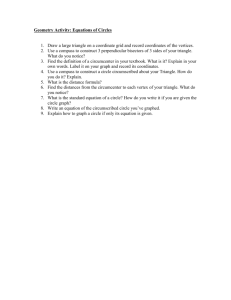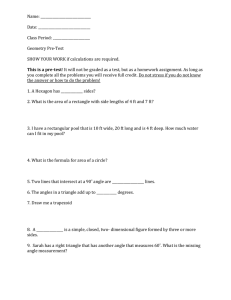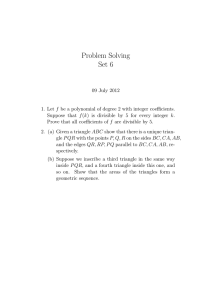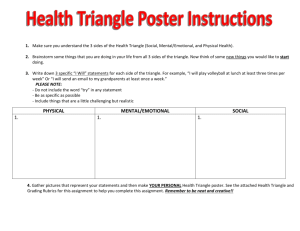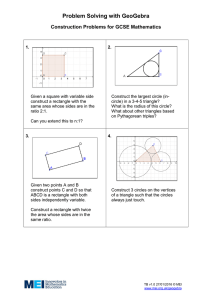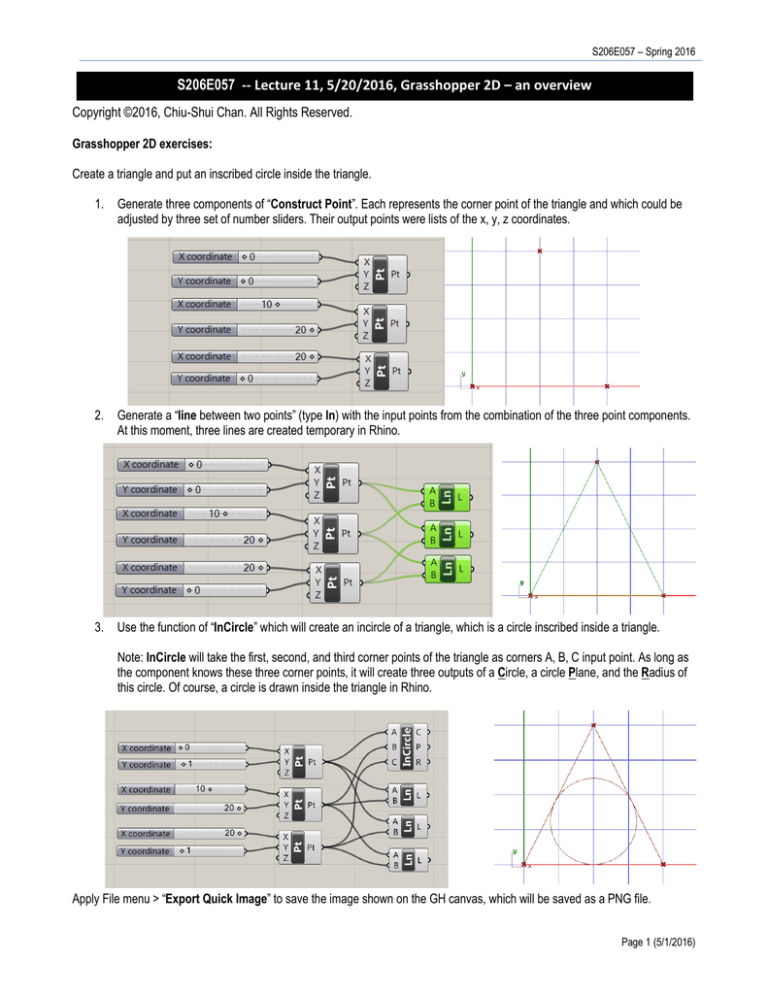
S206E057 – Spring 2016
S206E057 -- Lecture 11, 5/20/2016, Grasshopper 2D – an overview
Copyright ©2016, Chiu-Shui Chan. All Rights Reserved.
Grasshopper 2D exercises:
Create a triangle and put an inscribed circle inside the triangle.
1.
Generate three components of “Construct Point”. Each represents the corner point of the triangle and which could be
adjusted by three set of number sliders. Their output points were lists of the x, y, z coordinates.
2.
Generate a “line between two points” (type ln) with the input points from the combination of the three point components.
At this moment, three lines are created temporary in Rhino.
3.
Use the function of “InCircle” which will create an incircle of a triangle, which is a circle inscribed inside a triangle.
Note: InCircle will take the first, second, and third corner points of the triangle as corners A, B, C input point. As long as
the component knows these three corner points, it will create three outputs of a Circle, a circle Plane, and the Radius of
this circle. Of course, a circle is drawn inside the triangle in Rhino.
Apply File menu > “Export Quick Image” to save the image shown on the GH canvas, which will be saved as a PNG file.
Page 1 (5/1/2016)
Arch534 – Spring 2015
2nd Run: Put another triangle inside the circle plus an inscribe circle of the triangle.
4.
Use a “curve | line” component to solve interaction events for a curve and a line. It will take the “circle” output from the
InCircle and “line” outputs from the lines as its input. It also will generate an inscribe point as intersection point, and
parameter of the curve as output values. Then the three curve|line components will create three inscribe points as shown
in the following pictures.
5.
Use “Line” component to connect the three inscribe points on the triangle to generate a triangle inside the circle. See the
following image.
6.
Use InCircle, again, for generating the inscribed circle inside the second triangle. This will complete the second run of
execution and creation.
3rd Run:
Apply the same methods and procedures to execute the third run of generating a triangle inside an inscribed circle. In this third run
of generating the third circle within the third triangle, results will have the following image composition. The generation could keep
repeating again and again to create circles sitting inside of a triangle, which is the notion of recursive repetition. Now please work
it out yourself. Save the file on the desktop after it is completed.
Page 2 (5/1/2016)
S206E057 – Spring 2016
Recursive pattern:
Such repetitious procedures are the notion of repetition and recursion. Repetition is to apply the same steps over again. Recursion
is the process of repeating items in a self-similar way. The classic example of recursion is Fibonacci sequence.
Fib(0) = 0 as base case 1,
Fib(1) = 1 as base case 2,
For all integers n>1, Fib(n) := Fib(n-1) + Fib (n-2).
𝑓𝑓(𝑛𝑛 − 1) + 𝑓𝑓(𝑛𝑛 − 2), 𝑓𝑓𝑓𝑓𝑓𝑓 𝑛𝑛 > 1;
𝑓𝑓𝑓𝑓𝑓𝑓 𝑛𝑛 = 1;
0,
𝑓𝑓𝑓𝑓𝑓𝑓 𝑛𝑛 = 0;
F(n) = � 1,
Each copy of Fibonacci can create two new copies, not just one. Thus, Fibonacci is said to be doubly recursive. In mathematics,
the Fibonacci numbers or Fibonacci sequence are the numbers in the following integer sequence:
1, 1, 2, 3, 5, 8, 13, 21, 34, 55, 89, 144….
or formally written as…
0, 1, 1, 2, 3, 5, 8, 13, 21, 34, 55, 89, 144…
Thus,
Fib (3) = Fib (1) + Fib (2)
1 + 1 =
2
In this exercise, repetition could be implemented by recursion. A GH plug-in, HoopSnake, could be applied to do the job.
HoopSnake is a component that creates a copy of the data it receives at its input upon user request and stores it locally. In theory,
the component could send the output of a set of components back to its input in a looping fashion, which could open up some new
possibilities for iterative process modeling. HoopSnake could be downloaded from www.food4rhino.com page.
To install:
In GH, File > Special Folders > Components folder.
Save the gha file there.
Right-click the file > Properties > clean the “blocked” text
Restart Rhino and GH.
Page 3 (5/1/2016)
Arch534 – Spring 2015
Notions of recursion in HoopSnake – A math example.
There is the component of “Data Recorder” applied, which is the parameter that stored the data generated each time and kept the
data in Rhino as well. The data could be erased from clicking the X sign and record it again. When you click on the button, you
actually turn the component off. You have to turn it on again to make it workable. Here are the short descriptions of an example.
•
•
•
Index 0: When the algorithm starts, S (Starting Data) accepts 2, HS algorithm checks the data in D (Data) for output.
Data in D is empty (null) at this point, so HS takes the original data of 2 and pass it to F (Feedback). Here, F is supposed
to get a copy of the data from D for future actions, but, since D is null at this point, so it outputs 2 (shown in index 0) and
calls the next iteration of index 1. But, the iteration has not been done, so the number of “I” is 0.
Index 1: The first iteration starts from F having the data of 2, pass it to AxB for 4, the result gives back to D, and checks
if 4<7 is true for B (termination condition). If it is true, then 4 will be the data for F to start the next call for index2. At this
end of index 1, F has the value of 4, L has 0 loop left, and I has one iteration done.
Index 2: The second iteration starts with AxB, 4x2=8, 8<7 is false, so B (termination condition) stops the loop, and not
pass the data to F. So, at the end of this second iteration (index 2), F still has the value of 4, L has 1 loop that has not
completed, and “I” has one previous iteration done, so the value of iteration is 1, iteration 2 doesn’t count.
In this example, F provides input to components for generating outputs for D, which also provides data to F. Thus, it is the
recursive activity that repeats items in a self-similar way. The following one is the recursion for incircles of triangles.
In this example, the three corner points of the first generation of the triangle will be merged into a big list as the input of the
Hoopsnake which does the major recursion work. The long list will be exported to the List Item to do sorting for picking up the first
three points for the construction of the second generation of the triangle. The list serves as the next generation of the corner
points, which will be used to create a triangle and its incircle and feed back to the second merger again and ship to the Hoopsnake
(Data input part) for the remaining creation. Application – use it to generate repeated objects or structural patterns.
Page 4 (5/1/2016)

